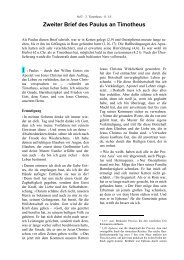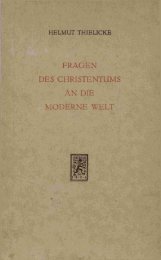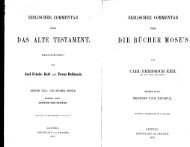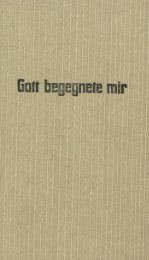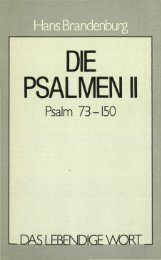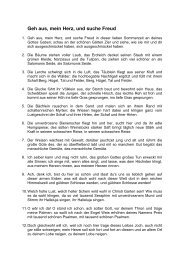Create successful ePaper yourself
Turn your PDF publications into a flip-book with our unique Google optimized e-Paper software.
denigrated the external human ear, with all its<br />
convolutions, as being pointless and useless, a<br />
degenerate left-over from some alleged evolutionary<br />
history. The little protrusion on the upper<br />
outside edge of the auricle has been known since<br />
then as “Darwin’s tubercle”. Generations of<br />
researchers after Darwin blindly accepted his verdict<br />
on the ear. But in reality, the whole beautiful,<br />
convoluted labyrinth that is our auricle is a precise,<br />
genetically programmed device which delivers<br />
an identical additional signal to the brain<br />
after a time lag of one five thousandth of a second<br />
( = 0.0002 s, see the diagram on page 24). In<br />
effect, one has four ears, two of which are located<br />
slightly higher than the other two. The result<br />
of this finely tuned system is that the brain is<br />
able to process six different values, two of them<br />
being the differences between the two upper<br />
”ears”, two more are those between the two<br />
lower “ears”, and the third pair is that between<br />
the lower “ear” on one side, and the upper “ear”<br />
on the other side (see the diagram on page 25).<br />
The required computations are carried out at<br />
lightning speed in the brain to give us a very<br />
sophisticated “sound image” of our surroundings.<br />
This structure is also crucial in our astounding<br />
ability to voluntarily suppress some sounds to<br />
the enhancement of others.<br />
Middle ear: After travelling along the external<br />
acoustic meatus, incoming sound waves strike<br />
the ear drum, which is set vibrating. The energy<br />
transferred in this way is passed on, as the three<br />
tiny, connected bones in the middle ear (malleus,<br />
incus, and stapes, or hammer, anvil and stirrup)<br />
transmit the sound vibrations through the oval<br />
window into the inner ear. Weighing only about<br />
10 mg, a tiny percent of the mass of the smallest<br />
of coins, these minute bones are the smallest in<br />
the entire human body.<br />
The hearing process involves the transfer of air<br />
vibrations into the liquid medium of the inner ear.<br />
In the normal course of events, the greater part of<br />
the sound energy would be reflected at an air/liquid<br />
boundary, and such losses would play havoc<br />
with the hearing process. To circumvent this, the<br />
Creator used a very ingenious interface structure<br />
which limits reflection losses to a negligible level.<br />
<br />
The cochlea<br />
<br />
<br />
Scala vestibuli<br />
Cochlear duct<br />
Scala tympani<br />
Sensory zone (organ of Corti)<br />
Vestibular membrane<br />
Helicotrema<br />
Round window<br />
Stapes in oval window<br />
<br />
<br />
<br />
<br />
This complex mechanism, comprising the ear<br />
drum and the three middle ear bones, exactly<br />
matches the sound wave impedance in air to that<br />
of the inner ear. The effective vibrational area of<br />
the ear drum is about 0.65 cm 2 , which is 20 times<br />
that of the oval window (only 0.032 cm 2 ). This is<br />
equivalent to an amplification factor of 20. In<br />
addition, the leverage afforded by the malleusincus-stapes<br />
linkup provides a further amplification<br />
factor of 3.<br />
Inner ear: It is clear that a massive amplification<br />
factor is involved in the conversion of air waves<br />
(at the ear drum) to the vibrations of the liquid in<br />
the cochlea. The inner ear, comprising both the<br />
balance organ and the cochlea (Latin cóchlea =<br />
snail), is housed in the solid bone of the skull. A<br />
second conversion takes place here; mechanical<br />
vibrations are changed into electric neural<br />
(nerve) impulses.<br />
The cochlear duct is filled with a highly viscous<br />
liquid (Latin viscum = birdlime, sticky, or thick),<br />
called the endolymph. There are two more liquidfilled<br />
spaces on either side, the scala vestibuli<br />
(Latin scala = steps; vestibuli = forecourt), and<br />
the scala tympani (Latin tympanum = drum).<br />
Both of these cavities are filled with a somewhat<br />
27




